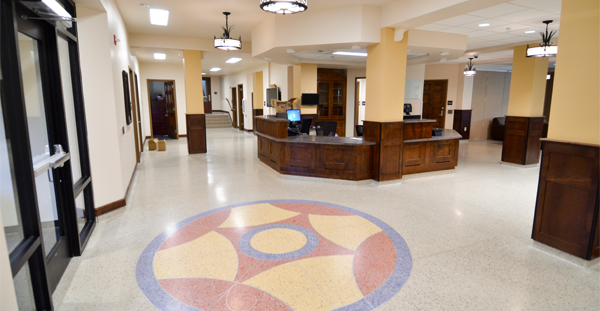Modern, historical meet in renovation of residence hall
Student input and creative architectural design are to thank for the melding of eras and the preservation of elements in the Baker Hall renovation, such as ornate iron light fixtures, fireplace facades, decorative woodwork, stone and roof tiles. (Photo: Patrick Campbell/University of Colorado)
The University of Colorado Boulder’s Baker Hall, closed the past 15 months for its first major renovation in more than 75 years, is welcoming 456 students this week with a modernized interior that better addresses the needs of today’s students while retaining the building’s original charm.
“The 1937 Baker building, the second-oldest residence hall at CU-Boulder, represented an exciting design challenge,” said Thomas Goodhew, assistant director of planning. “The renovation needed to modernize while honoring the building’s rich architectural style created by Charles Klauder. His vision set the campus aesthetic that we enjoy to this day.”
Klauder, who was known for his architectural work on university campuses across the country, designed 15 CU-Boulder buildings between 1920 and 1938 including Baker and Sewall Hall. Other CU-Boulder fixtures that he designed include Norlin Library, the University Club and the Economics Building.
Student input and creative architectural design are to thank for the melding of eras and the preservation of elements in the Baker renovation, such as ornate iron light fixtures, fireplace facades, decorative woodwork, stone and roof tiles, Goodhew said.
All of the residents are participating in the Baker Residential Academic Program (RAP) held in the building. CU-Boulder has 14 RAPs, programs that integrate courses, educational opportunities and social events among classmates within residence halls along with a high level of faculty engagement.
The Baker RAP is for first- and second-year undergraduates in natural sciences, pre-health and environmental studies. It also offers classes that fulfill core graduation requirements such as political science, philosophy and anthropology.
Some of the 18 courses taking place in the Baker RAP this fall will be in geology, environmental studies, biology, chemistry and weather and the atmosphere, said Cindy Carey, director of the Baker RAP.
“In addition to formal courses, we provide co-curricular adventures that emphasize nature and the environment such as rock climbing, backpacking, volunteer activities and internships,” Carey said. “And we’ve tied the RAP theme into the building renovation, naming the floors of Baker after environments such as ocean, mountain and desert.
“There are visual cues that go along with each floor’s environment, like subtle paint colors, photographs and quotes on display from various people about the value of nature and the importance of protecting the environment,” she said.
Not only do the visual cues of the floors build awareness, but they also help with way-finding, distinguishing various locations in the building from each other, according to Goodhew.
One of the more major changes in the renovation was a transformation of the building’s south side. Formerly a loading dock, the south side now is an entrance that opens internally to split-level common spaces, an academic suite of classrooms and faculty offices, a new round-the-clock front desk and a kitchen for student use. The original north-side entrance remains in place.
Baker now is compliant with the Americans With Disabilities Act and boasts a number of sustainability features that are the standard of new construction on campus to reduce carbon emissions and operating costs. It is designed to receive a “platinum” Leadership in Energy and Environmental Design (LEED) rating, the highest possible designation from the United States Green Building Council.
The building’s “green” features are especially evident in each student room including “smart” heating and cooling units that automatically turn off when windows are open, vacancy sensors that automatically shut off lights in empty rooms and power outlets that can be switched off to prevent energy consumption when appliances are not in use.
Baker also is outfitted with low-flow plumbing, energy-efficient lighting and increased natural light throughout, as well as a water bottle refill station that displays an estimate of the number of plastic bottles diverted from landfills as users fill up.
State-of-the-art washing machines installed in Baker for student use are the first of their kind on campus. They use only cold water, reducing energy needs, and get clothes cleaner through an oxidization process that breaks down the molecular bonds that hold dirt to clothing, having a disinfecting effect.
The $41.5 million renovation includes 115,000 square feet, 456 beds, 256 student rooms, a hall director apartment, a faculty apartment, four classrooms and 10 faculty offices.
The total cost of the project will be financed through available cash and bonds that will be repaid through room and board rates.
Following the renovation of the Kittredge West residence hall in 2012-13, the Baker project is part of a series of efforts to enhance CU-Boulder’s RAPs and to bring the campus’s buildings to current-day standards of quality and efficiency.
For more information about CU-Boulder’s residence halls visit http://housing.colorado.edu/residences/residence-halls. For more information about Baker Hall and the RAP visit http://bakerrap.colorado.edu/about-baker-hall.


